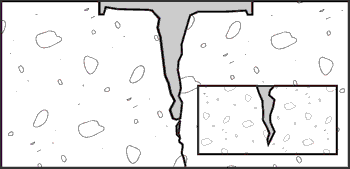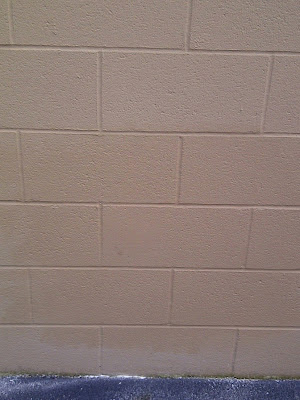At Roadware, we see lots of two-component polymer concrete repair products that claim to be just like Concrete Mender™. One even calls it self, “Quick Mender.” They are all basically polyurea based products that are too thick to effectively penetrate concrete surfaces and are so reactive, they become too sticky and gooey to trowel in just a minute or two after mixing. When you dig a little deeper, you will see a very distinct difference in genuine Roadware 10 Minute Concrete Mender™.
- What is Concrete Mender? ProprietaryPolyurethane Blend
- Formulation: Classified
- Manufacturing: South Saint Paul, Minnesota, USA
- Origin: NATO program for rapid bomb damage repair on runways.
- Function: To penetrate deep into concrete cracks, joints, and spalls creating a structural repair in 10 minutes.
- Military Use: Classified
- Civilian Use: Repair cracks, joints and spalls in commercial, industrial and civil applications.
- Service Life: Indefinite
- Cure Time: 10 Minutes at 70°F (21°C)
- Distribution: Worldwide Distributor Network
Surface Tension:
Surface Tension is a measurement of the ability of a liquid to overcome its own internal friction and penetrate into a material like concrete. Roadware 10 Minute Concrete Mender™ has a surface tension One third of water. It will penetrate concrete cracks and fissures quicker and deeper than water. This low surface tension lets Concrete Mender™ penetrate normal bond lines and allows structural bonding with the aggregate in the concrete. See the electron microscope slide below.
Low surface tension has another little hidden benefit. It allows Roadware 10 Minute Concrete Mender™ to be combined with more than two parts sand and still be workable and trowel-able. Try that with a polyurea and you will have a gooey mess on your hands.

Structural Polyurethane
Roadware 10 Minute Concrete Mender™ is a polyurethane based material that restores structural integrity and aggregate interlock to distressed concrete by using low surface tension and low viscosity to penetrate concrete surfaces and cross -linking polymer chains to bond directly to the concrete-aggregate matrix. This bonding action utilizes capillary forces to self-inject polymer chains into the surrounding concrete. This material should have a modulus of elasticity less than the surrounding concrete and should not become brittle over time. This material may be combined with manufactured sand to form a PCC compatible polymer concrete that can structurally repair concrete cracks and spalls.
Advantages– Due to the very low surface tension of the material and low viscosity, complete saturation bonding of cracks can be easily achieved. Minimal prep to remove loose debris is all that is normally required. This can be considered a structural repair if the material is allowed to gravity flow to the full depth of the crack. Manufactured sand or quartz may be introduced into the repair as necessary to prevent under slab ponding and martial waste. For repair greater than 0.125 inches, specified sand may be added at a ratio of two parts sand to one part mixed polyurethane as the crack is filled to extend the material and add strength. The sand also brings the thermal coefficient of expansion of the repair material closer in-line with surrounding concrete. Polyurethanes of this nature may be applied in a wide range to substreight temperatures making them useful in frozen and cold storage warehouse applications or cold weather application below -20F (-23C). Repairs are typically ready to accept traffic in approximately 10 minutes at 72F (22C).
Toughness:
Roadware 10 Minute Concrete Mender™ mixed with sand gets about as hard as concrete, yet it’s modulus of elasticity is slightly less than concrete so it will move with the slab, not work against it.



Easy Floor Crack Injection using cartridges:
Roadware 10 Minute Concrete Mender can be injected into a wide range cracks and delaminations using a simple cartridge and special Soft-tip injection mixers. Successful full-depth repairs have been made in 24″ of concrete.



Vertical Crack injection
For fast and easy vertical crack injection on walls and structures, we recommend the Gebbie Tech System
THE GEBBIE TECH SYSTEM TRANSFORMS VERTICAL CONCRETE WALL REPAIR
- Comprehensive testing by Opus International Consultants – repairs have consistently achieved results higher than the manufactured panel.
- Full training in the system – a step by step training video and instructional booklet is included within each kit.
- Save time and money! Conventional repair methods with epoxy have longer repair times, additional downtime and are more expensive.
- Use a hand gun – no need for expensive pumps! The Gebbie Tech System uses the cost effective Roadware 10-Minute Concrete Mender™ hand gun to repair walls.
- Complete penetration. Due to the composition of the Roadware 10-Minute Concrete Mender™ the resin travels easily from the injection point.
- The approved vertical wall repair system. The Gebbie Tech System is listed in Roadware’s 10 Minute Mender Concrete Data Sheet as the approved method of vertical concrete wall repair.
- Repairs cracks from a hairline through to quarter inch. Walls are repaired within 2 – 12 hours depending on the temperature, and the length of the cracks.
Polishable:
Polishing your floor to a mirror like finish? Repairs made with Roadware 10 Minute Concrete Mender™ will not smear into the surrounding surface or gum-up diamond polishing pads. You can even add natural sand to match the grain and color of the surrounding concrete.
Lower Cost:
By adding two parts silica or quartz sand to a gallon of Concrete Mender™ you will yield about 2.2 gallons of repair material.
A gallon of polyurea or epoxy will yield a gallon of repair material. That makes polyurea more expensive to use even at half the material cost! This does not even factor in the hidden costs of short repair life, damage to the surrounding concrete caused by pre-mature failure, or the cost of redoing the repairs when they fail.


Packaging:
Roadware 10 Minute Concrete Mender™ hand packed with state-of-the-art packaging materials. They have to be good. The very low viscosity and surface tension require it.


Freezers:
Working in the cold? We’re from Minnesota. We know first hand what it takes to work in freezing temperatures. Roadware 10 Minute Concrete Mender™ can be applied at temperatures below -30 F ( -34C). That is really cold. Exposed flesh will freeze in seconds. That is almost too cold to go ice fishing. Most repair products would freeze solid before curing and quickly fail. Roadware 10 Minute Concrete Mender™ generates its own heat. Curing will take several hours, but you will still get the same great performance.



History:
For over twenty years, Roadware 10 Minute Concrete Mender™ has performed without fail in thousands of applications. Many times outliving the facility itself.

repairs with Concrete Mender™.
| Concrete Mender repair in a cold storage warehouse after 15 years of heavy forklift traffic. |
Utilizing technology developed to repair bomb damaged runways for NATO, Roadware 10 Minute Concrete Mender™ was reformulated and brought to commercial markets in the early 1990’s. You can find us in nearly every industry that has concrete floors, decks, slabs or surfaces.
Links:
Roadware 10 Minute Concrete Mender™
Availability:
Roadware 10 Minute Concrete Mender is made in the USA and is available from Roadware authorized distributors and dealers worldwide. Call 1-800-522-7623 or 1-651-457-6122 to find a dealer near you.
Specifications:

















































